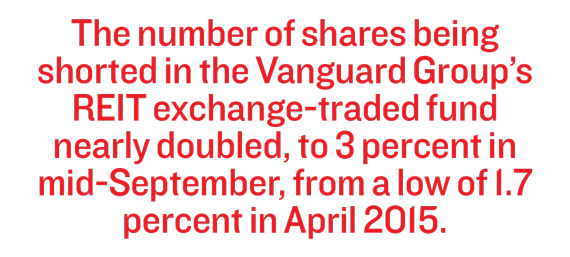 J. Kyle Bass is famous for predicting the U.S. housing crisis and making millions of dollars shorting subprime mortgage bonds in 2008. So when the hedge fund manager announced this February that he shorted the obscure residential real estate investment trust United Development Funding IV, its other investors apparently decided it was best to get out of the way.
J. Kyle Bass is famous for predicting the U.S. housing crisis and making millions of dollars shorting subprime mortgage bonds in 2008. So when the hedge fund manager announced this February that he shorted the obscure residential real estate investment trust United Development Funding IV, its other investors apparently decided it was best to get out of the way.
Within a day of Bass publishing an open letter announcing his short, the Dallas-based REIT’s share price had dropped by 30 percent. Within a week, those shares had fallen by 69 percent and then stopped trading entirely after the FBI raided the headquarters of its parent company.
The hedge fund manager had won again.
Bass, who accused UDF of running a Ponzi scheme, wasn’t betting against any particular submarket, let alone the real estate industry as a whole. But his bet stands for something broader — that shorting real estate is increasingly back in vogue.
It’s been close to nine years since a handful of hedge fund managers made a fortune betting against the toxic residential mortgage-backed securities (RMBS) market, which was immortalized in Michael Lewis’ book (and the subsequent film) “The Big Short.” Now, a growing number of observers are cautioning that the next real estate downturn is about to begin, if it hasn’t already. This decline creates potential opportunities for cynics to benefit from other people’s losses.
The question now is: Are we about to witness the next big short? If so, it could largely involve commercial properties and companies, as well as publicly traded residential firms similar to UDF, industry sources say.
“The debate has intensified over the last couple of months,” Richard Hill, head of U.S. REIT equity and commercial real estate debt research at Morgan Stanley, told The Real Deal. Hill added that his clients are increasingly asking about shorting options for commercial mortgage-backed securities (CMBS).
Short order
On the one hand, the opportunities for short selling real estate today seem far fewer than they were in 2006 and 2007. For a successful short, it’s not enough to predict that the market will take a turn for the worst. One must also bet that most other investors are underestimating how severe the problem is, which would leave asset prices overvalued.
Prior to the 2008 financial crisis, a few skeptics predicted that the housing market would collapse entirely — sending a shock to the U.S. and global financial systems — while the majority argued that the market was essentially unbreakable. This stark difference of opinion led to enormous profits for those who bet on the worst-case scenario.
 Today, differences of opinion are far more nuanced. Virtually no one is predicting an all-out collapse. Instead, bulls and bears disagree over whether the real estate business is merely slowing down or entering a downturn, and over which sectors will be hardest hit. That creates shorting opportunities in certain corners of the market, but a repeat of the wins and losses seen during the last collapse seem far-fetched. And the U.S. housing industry is widely considered stable.
Today, differences of opinion are far more nuanced. Virtually no one is predicting an all-out collapse. Instead, bulls and bears disagree over whether the real estate business is merely slowing down or entering a downturn, and over which sectors will be hardest hit. That creates shorting opportunities in certain corners of the market, but a repeat of the wins and losses seen during the last collapse seem far-fetched. And the U.S. housing industry is widely considered stable.
In commercial real estate, however, new cracks are starting to show, as several sectors may be near or past their peaks.
First, a larger share of investment in commercial properties than ever before is now in public hands. In August 2016, the National Association of Real Estate Investment Trusts’s REIT index — which tracks the performance of the industry — was 53 percent above its precrisis peak. Since 2008, 68 real estate companies have gone public, according to NAREIT. Meanwhile, in recent years, CMBS issuance has exploded (though it still remains below precrisis record levels).
That growth matters because publicly traded real estate is much easier to short than its private counterpart. And the less private real estate becomes, the more likely shorting is to occur.
“We’re now seven years into a recovery, and the sense is there’s probably more downside risk than upside opportunity,” said Douglas Hercher, a principal at the hospitality investment sales brokerage Robert Douglas.
As of mid-August, 3.8 percent of all REIT shares (around 557 million shares) were held in a short position, according to the New York investment banking shop Sandler O’Neill. That’s slightly below the 4 percent average for all U.S. stocks, and a far cry from retail and consumer durables, where 4.8 percent of shares are shorted.
But shorting in the publicly traded real estate arena appears to be on the rise, according to multiple sources. The percentage of shares being shorted in the Vanguard Group’s REIT exchange-traded fund — a leading fund that tracks the values of a range of REIT stocks — nearly doubled, to 3 percent in mid-September, from a low of 1.7 percent in April 2015.
“The issue with shorting REITs is that because they are generally pretty high yielding, it’s actually relatively expensive to short them,” said Edward Mui, a REIT analyst at Morningstar. “This forces short sellers to have a strong conviction,” he added.
In simplified terms, investors short REITs by borrowing shares and selling them, then agreeing to buy them back and return them to the lender at some point in the future. If the share price falls in the interim, the investor will spend less money buying them back than he or she made selling them — and can keep the difference as a profit.

Kyle Bass
But while the shares are borrowed, the investor has to pay the lender the equivalent of any dividends on the stock. REITs tend to pay out higher dividends on average than other stock market categories; as a result, shorting them is comparatively more expensive, according to sources. On average, REIT share prices are also more stable than other stocks, including financial and tech firms, which also presents a disadvantage for those looking to take a short position.
“You’ve got such predictable and sustainable earnings, don’t you want to short companies that are less predictable?” Brad Thomas, an investor and columnist who co-wrote the book “The Intelligent REIT Investor,” told TRD.
Despite these headwinds, short investors are currently doubling down on two types of REITs: data centers and hotels. As of August 15, 11.1 percent of data center REIT shares (around 28.4 million shares) were being shorted, according to Sandler O’Neill. Meanwhile, 8.1 percent of hotel REIT shares were being shorted, and because the hotel industry is much larger, that amounts to around 171 million shares.
Prime targets
Both data centers and hotels face high uncertainty during financial downturns, which makes them ideal candidates for shorting. Data center REITs depend on a healthy tech sector, said Sandler O’Neill analyst Alex Goldfarb, and with warning signs of a bursting tech bubble increasing, bears have plenty of reasons to bet against them.
San Francisco-based Digital Realty Trust, the most heavily shorted REIT at 18.4 percent, saw its volume of short interest increase by nearly 20 percent between mid-August and mid-September, according to data from the U.K. research firm IHS Markit. Digital Realty, which owns close to 90 percent of the buildings in its portfolio, has leasehold interests in three Manhattan data centers, located at 60 Hudson Street, 32 Avenue of the Americas and 111 Eighth Avenue. A Sept. 26 report by Citibank argued that the REIT’s high level of shorting is “due to its forward equity offering.”
Digital Realty is looking to issue new stocks to fund the acquisition of eight data centers in Europe, a spokesperson for the company told TRD. “Once the forward sale agreements have been settled, we would expect to see short interest return to more normalized levels,” the spokesperson said.

From left: Alex Goldfarb, Douglas Hercher and Darrell Wheeler
Among hotel REITs, Pebblebrook Hotel Trust (14.6 percent), Host Hotels & Resorts (12.4) and LaSalle Hotel Properties (12.1) were the most-shorted stocks as of mid-August. Pebblebrook owns six upscale Manhattan hotels, including The Benjamin at 125 East 50th Street and the Affinia Manhattan at 371 7th Avenue. Host Hotels also owns six Manhattan properties, including New York Marriott Marquis and Westin Grand Central. LaSalle owns four New York hotels, including the Park Central and The Roger. Representatives for the three hotel REITs were unavailable for comment.
U.S. hotels are struggling with the rise of Airbnb, a strong U.S. dollar, a looming supply glut in Manhattan, and fears over an economic slowdown. “Hotels tend to be the canary in the coal mine,” said Hercher of Robert Douglas. Because hotel guests take rooms on a short-term basis, revenues tend to fall more quickly in economic downturns compared with office and residential properties.
Wes Golladay, a hotel analyst at RBC Capital Markets, said the surge in new supply and a recent dip in business travel amid falling corporate profits have formed the biggest clouds over the hotel industry this year.
“Pebblebrook and LaSalle are both geared toward business travelers,” he said. “That is their bread and butter and that is the part that is soft.”
But there are strong differences of opinion over how big of a threat these factors are. While many believe that Airbnb poses an ongoing threat to the hotel industry, hospitality executives often counter that renting a room in a stranger’s apartment can never compete with a clean hotel. And some analysts argue that Airbnb’s impact is already priced in.
In Manhattan, one of the world’s top hospitality markets, hotel revenues and cap rates have fallen since mid-2015, though industry insiders often claim the hotel market will rebound in the next few years.
“I think we’re going to turn the corner by the third quarter of next year,” Hercher said, speaking of New York’s hotel market. “Every other market in the country would kill to have New York’s numbers.”
Beyond hotels and data centers, major short positions on REITs are scarce, but examples can still be found.
Mack-Cali Realty Trust saw 6.7 percent of its shares being shorted as of mid-August, down slightly from 7.1 percent at the end of July, according to Sandler O’Neill. The New Jersey-based REIT struggled in the years following the financial crisis amid a broader weakness in the suburban office market — its primary source of revenue. In June 2015, the company hired a new CEO, Brookfield Office Properties veteran Mitch Rudin, and embarked on a turnaround strategy. Mack-Cali’s share price rose 65 percent, to $27.81 as of Sept. 28, up from $16.90 in May 2015.
Although some investors believe that the bulls have gotten a little ahead of themselves, so far those skeptics are in the minority. John W. Guinee III, an analyst at the financial services firm Stifel, Nicolaus & Co., argued that Mack-Cali’s stock “looks very cheap to us and most knowledgeable investors.”
SL Green Realty Corp., New York City’s largest office landlord, has also seen above-average shorting (5.4 percent) amid concerns over a supply glut in the Manhattan office market. Fellow office REITs Vornado Realty Trust (1.6 percent) and Boston Properties (1.9) remain less of a target for short sellers.
 The big unknown is whether REIT shorting will increase in the near future. Morgan Stanley’s Hill, for one, said a growing number of his clients are taking a “more cautious” view on the REIT market.
The big unknown is whether REIT shorting will increase in the near future. Morgan Stanley’s Hill, for one, said a growing number of his clients are taking a “more cautious” view on the REIT market.
Much depends on the Federal Reserve’s interest rate policy — or rather the market’s expectations of it. “If you have the view that interest rates are going up, then yeah you’re going to short the group,” said Goldfarb of Sandler O’Neill, referring to REITs as a whole.
Higher Treasury yields typically translate to higher mortgage rates and make bonds look more attractive compared to real estate. That puts downward pressure on property prices and by extension REIT stocks, according to sources. But so far, all analysts interviewed for this story said they expect Treasury yields to remain low for the foreseeable future.
A second factor that could encourage shorting is largely bureaucratic. In September, REITs received their own classification in the S&P 500 and MSCI stock indices, where they were previously grouped with financial and insurance firms. Several observers have argued that the change could increase visibility and investor interest. But conversely, it could also boost shorting.
The more educated investors become, the more they notice opportunities for short bets, said Mui of Morningstar, noting that the more exposure the asset class gets, “the more blood will be in the water.”
The CMBS effect
In “The Big Short” before the last financial crisis, CMBS played second fiddle to the subprime residential mortgages that caused the housing bubble to burst. Even though hedge funds such as Los Angeles-based Lahde Capital Management had placed big bets to short CMBS during that time, the most outrageous profits were made on RMBS.
Today, that dynamic looks fairly different. While the U.S. housing market is widely considered stable, market bears now see overleveraged commercial real estate deals as a potential target.
And much like the case with REITs, CMBS shorting is on the upswing, according to multiple sources. One good indicator is the dollar volume of long bets on post-2012 CMBS indices minus the dollar volume of short bets. If the sum is growing, long bets dominate. If it is falling, short bets likely take up a larger share of the market.
As of Aug. 26, the net sum stood at $4.76 billion, down from $5.21 billion six months ago and $6.49 billion a year ago, data from the post-trade financial services firm the Depository Trust & Clearing Corporation show.
Investors short securitized commercial debt deals by buying derivatives on indices known as CMBX — which track CMBS performance.

Digital Realty has a long-term lease on 60 Hudson Street, which could be a target for short sellers as the tech economy softens.
“When people say ‘Hey, I need to short real estate,’ they get pointed to the CMBX,” one analyst told TRD on condition of anonymity.
There are currently nine such indices — CMBX.1 to CMBX.9 — and each one tracks the performance of a basket of specific CMBS transactions, usually issued within a year. CMBX.1 to CMBX.5 track CMBS issued prior to 2008, while CMBX.6 to CMBX.9 are based on post-crisis bonds.
The most aggressive short bets are currently being placed on loans tied to retail deals closed in 2012, which happen to be part of the CMBX.6 index, according to Hill. “There has been a significant debate about CMBX.6 over the past months given the prevalence of loans secured by malls,” he said.
A flurry of store closures across the U.S. has sent retail valuations down from 2012 levels, sparking fears that mall owners who bought or refinanced their properties at peak prices could default on their loans. “In some cases, the loan-to-value ratios of these loans are now approaching 100 percent and that’s only a few years afterwards,” Hill said.
A recent Morningstar Credit Ratings report found that mass store closures by department store giant Macy’s could impact as much as $3.64 billion in CMBS issued since 2010. Meanwhile, Sears, JCPenney, and Sports Authority pose their own threats.
And it’s not just securitized retail debt that’s feeling the heat. As of Aug. 26, the CMBX.8 — based on all CMBS deals issued in 2014 — was one of the few indices where investors placed more short bets than long bets in its BB tranche, at a net difference of $50.3 million. These bonds suffer from looser underwriting standards and are heavily exposed to multifamily buildings in now-struggling oil producing regions such as Houston and parts of North Dakota, as well as underperforming hotels.
While 2012 deals at least benefited from a continued market boom in 2013 and 2014, which drove up asset values, 2014 deals closed at peak prices and are generally more vulnerable to a downturn, Hill explained.
Darrell Wheeler, head of structured finance research at S&P Global, said new CMBS deals issued in 2016 could be even more at risk if the real estate market goes south. Traditionally, 70 or more individual mortgages have supported a CMBS pool, he said, but this year a growing number of multi-loan conduits consist of only 25 to 40. With fewer loans in a CMBS transaction, one or two of them defaulting would have a bigger impact on the value of the whole. The CMBS market is also now exposed to a high volume of interest-only loans on commercial properties, Wheeler added.
Those factors alone create several opportunities for market skeptics to go short.
And as with REITs, 2016 is a year of big bureaucratic changes for the CMBS, which could raise the stakes for those taking short bets. This December, new risk retention rules will go into effect requiring CMBS issuers to keep a portion of their loans on their books. The requirement will make it more expensive for banks to originate securitized commercial real estate loans while weeding out the bad seeds.
“Many firms have assessed that the market will be more volatile than prior years,” said Sean Barrie, a research analyst at the CMBS data firm Trepp. “The regulation has caused some lenders to pull their loans back from the securitization sector, and a few have stepped out of the conduit lending game altogether.”
It doesn’t help that the market is bumping up against the much-decried “Wall of Maturities” — a staggering $105.8 billion in CMBS deals set to expire by 2018.
“We have been vocal that we think the refinancing rate for loans coming due in 2017 will be lower than the market anticipates,” said Hill. “And we think the default rate will be higher.”
Private affairs
In theory, virtually every American is either going short or long on the private real estate sector. Whether they want to or not, apartment renters short the housing market: They benefit from a real estate downturn because it drives down their rental payments. Homeowners, by contrast, go long on the market: They benefit from asset appreciation and increased rental income during a market upswing.
For institutional investors, however, shorting real estate assets that change hands privately rather than on stock or bond markets is a tricky bet. While REIT stocks and CMBS bonds are constantly being traded — which makes their prices fluctuate and shorting all the more possible — private commercial property values are much harder to forecast. Investors may believe that office buildings in certain parts of Manhattan will be worth less in the coming year, but if none of them trade during that time, any change in value remains hypothetical.
To get around that, those looking to short private real estate use the National Council of Real Estate Investment Fiduciaries’ Property Index (NPI). The index tracks the returns on private U.S. real estate owned by institutional investors. A handful of banks hold licenses to issue derivatives on the index, meaning investors can place long or short bets on its performance. But the NPI index tracks only a small share of the U.S. real estate market and is based on property appraisals rather than actual sales.
Shorting private real estate played virtually no role in the U.S. before 2008. As of December 2007, a mere $500 million in derivative trades on the NPI had been completed. The index has no relevant data for 2016, according to a spokesperson.
But private real estate derivatives are still virtually nonexistent today, said Kelly Haughton, CEO of Global Index Group, a company that creates and markets
derivatives across a range of industries. Haughton is currently working on a private real estate derivative, he told TRD. “We believe there’s a lot of demand for these kinds of securities and has been for quite some time,” he said.
Pointing to economist Robert Shiller, who found that markets often behave irrationally and are prone to crashes, Haughton added: “If things get irrationally exuberant, you want to have a tool that allows you to bet it’s irrational and that it will come back down.”
Haughton’s future customers, and many of the investors who currently short REITs and CMBS, are betting that there is more trouble ahead for the real estate industry than most people realize. If they are right, the New York market may soon deal with more conservative REITs and less accessible CMBS financing.
But at least the city has deep-pocketed Chinese investors, right?
It turns out Bass has something to say about that. Not long after his short of UDF, the hedge fund manager had picked a new, much larger target: China. He argued that the country was on the verge of a financial crisis amid a surge in bad bank loans, and he took foreign exchange positions betting on a steep devaluation in the yuan, China’s currency, .
“There are so many perfect parallels to the U.S. mortgage credit system or the European banking system and the Chinese banking system,” Bass said in a July interview with Real Vision TV, which brands itself as the “Netflix of finance.”
“There are things that go on in those systems that show you there are problems. We see it starting now.”